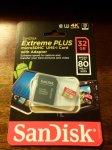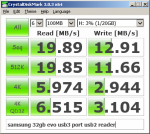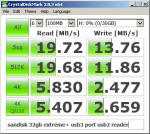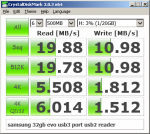catchingup
Member
I tested the current Sandisk 32gb Extreme Plus micro sd, uhs-1 U3 inside our F6 phone.

Summary:
Details:
A1 SD BENCH for sandisk extreme+
random i/o:
18.04 / 2.29 MB/s test1 fat32
16.66 / 1.79 MB/s test2 fat32
17.69 / 1.85 MB/s test3 fat32
16.36 / 0.71 ext4. multiple tests. Hmm.... ext4 write is much slower than fat32
15.64/0.85 ext4
Accurate:
57.75 / 29.46 fat32
57.89 / 27.56 ext4
A1 SD Bench for eMMC
random i/o:
19.31 / 0.2
accurate:
43.78 / 12.81
A1 SD Bench for Samsung EVO:
Random i/o:
15.49/0.72 ext4
13.55/0.58 ext4
17.22/0.76 ext4
17.41/1.97 fat32
Accurate:
35.7/9.09 ext4
34.3/14.1 ext4
35.8/14.94 fat32
-----------------------------------------------------------
In actual phone usage....
WV sd hack copying step to sd card much faster.
Apps load as fast as (or maybe even a hair faster than) eMMC, though the eMMC and samsung evo are no slouch either when it comes to normal phone usage.
Either card will give you a smooth experience.
493MB file copied from sdcard to eMMC in 90s = slow as f*** for some reason.
PC to eMMC transfer over usb:
493 MB file transfer from PC to eMMC in 54 seconds = ~9.13 MB/s
PC to sandisk over usb:
493MB file PC->ext4 partition (WV hack) in 31s = ~ 16 MB/s.
493MB PC->fat32 in 31s = ~16 MB/s
493MB fat32->PC in 31s = ~16 MB/s
493MB file ext4->PC in 37s = ~13.32 MB/s
PC to samsung evo over usb:
493MB PC->ext4 in 51s = ~9.6 MB/s write
493MB PC-> fat32 in 47s = ~10.5 MB/s write
493MB fat32 ->PC in 27s = ~18.25 MB/s read
493MB ext4 ->PC in 31s = ~16 MB/s read
Below, Samsung and sandisk were tested in PC usb2.0 card reader plugged into usb3 port. Crystaldiskmark test comparison between sandisk and samsung. Obviously the card reader is a huge bottleneck. Google will show that the sandisk has much faster speeds.
But one thing to note is that 4K r/w on the samsung beats the sandisk on the 100MB test, but in the 500MB test, the samsung random write slows down a lot while the sandisk maintains roughly the same performance.




Conclusion:
In the phone, the sandisk has much faster large file read/write than both the eMMC and EVO. I'm not sure if this means much in real world usage. Big apps?? The sandisk allows faster file transfers from PC to phone. Other than that, you likely won't notice a difference in daily usability.
The lowest price seen on this sandisk 32gb Extreme Plus was $17 around Black Friday.
Lowest price for 32gb samsung evo is $13.
For $4 more on sale, the sandisk has presumably better quality MLC memory, much faster speeds, and a lifetime warranty with free shipping both ways if you ever need to RMA.
The samsung has cheaper and slower and lower-life TLC memory, a 10 year warranty, and samsung doesn't cover the cost for you to ship a broken card to them when you RMA. Like other companies, they will ship a replacement for free though.
If you can get the sandisk for $17, it's a no-brainer. With up to 80 MB/s read and 50 MB/s write in sequential mode in non-phone applications, it's more than suitable for DSLR, gopro, camcorders, future phones with inevitable higher video recording demands, etc.
Faster-than-phone performance and lifetime warranty is just icing on the cake.
.

Summary:
- Holy sh** it's fast.
- The F6 sd card reader can push faster than the eMMC.
- Inside the F6, the Extreme+ blows 32gb Samsung EVO away, with ~60% faster sequential read and ~95% faster sequential write. Random r/w speeds are the same between both cards based on limited benchmark, but huge amounts of random data may show Sandisk coming out ahead.
- PC to phone transfers still slow over usb cable, so you'll need to pull the card out and use a UHS-1 reader for the fastest transfers. Sandisk Ex+ transfers faster from PC to phone, but Samsung EVO may read faster from phone to PC.
- Real world performance difference negligible.
Details:
A1 SD BENCH for sandisk extreme+
random i/o:
18.04 / 2.29 MB/s test1 fat32
16.66 / 1.79 MB/s test2 fat32
17.69 / 1.85 MB/s test3 fat32
16.36 / 0.71 ext4. multiple tests. Hmm.... ext4 write is much slower than fat32
15.64/0.85 ext4
Accurate:
57.75 / 29.46 fat32
57.89 / 27.56 ext4
A1 SD Bench for eMMC
random i/o:
19.31 / 0.2
accurate:
43.78 / 12.81
A1 SD Bench for Samsung EVO:
Random i/o:
15.49/0.72 ext4
13.55/0.58 ext4
17.22/0.76 ext4
17.41/1.97 fat32
Accurate:
35.7/9.09 ext4
34.3/14.1 ext4
35.8/14.94 fat32
-----------------------------------------------------------
In actual phone usage....
WV sd hack copying step to sd card much faster.
Apps load as fast as (or maybe even a hair faster than) eMMC, though the eMMC and samsung evo are no slouch either when it comes to normal phone usage.
Either card will give you a smooth experience.
493MB file copied from sdcard to eMMC in 90s = slow as f*** for some reason.
PC to eMMC transfer over usb:
493 MB file transfer from PC to eMMC in 54 seconds = ~9.13 MB/s
PC to sandisk over usb:
493MB file PC->ext4 partition (WV hack) in 31s = ~ 16 MB/s.
493MB PC->fat32 in 31s = ~16 MB/s
493MB fat32->PC in 31s = ~16 MB/s
493MB file ext4->PC in 37s = ~13.32 MB/s
PC to samsung evo over usb:
493MB PC->ext4 in 51s = ~9.6 MB/s write
493MB PC-> fat32 in 47s = ~10.5 MB/s write
493MB fat32 ->PC in 27s = ~18.25 MB/s read
493MB ext4 ->PC in 31s = ~16 MB/s read
Below, Samsung and sandisk were tested in PC usb2.0 card reader plugged into usb3 port. Crystaldiskmark test comparison between sandisk and samsung. Obviously the card reader is a huge bottleneck. Google will show that the sandisk has much faster speeds.
But one thing to note is that 4K r/w on the samsung beats the sandisk on the 100MB test, but in the 500MB test, the samsung random write slows down a lot while the sandisk maintains roughly the same performance.




Conclusion:
In the phone, the sandisk has much faster large file read/write than both the eMMC and EVO. I'm not sure if this means much in real world usage. Big apps?? The sandisk allows faster file transfers from PC to phone. Other than that, you likely won't notice a difference in daily usability.
The lowest price seen on this sandisk 32gb Extreme Plus was $17 around Black Friday.
Lowest price for 32gb samsung evo is $13.
For $4 more on sale, the sandisk has presumably better quality MLC memory, much faster speeds, and a lifetime warranty with free shipping both ways if you ever need to RMA.
The samsung has cheaper and slower and lower-life TLC memory, a 10 year warranty, and samsung doesn't cover the cost for you to ship a broken card to them when you RMA. Like other companies, they will ship a replacement for free though.
If you can get the sandisk for $17, it's a no-brainer. With up to 80 MB/s read and 50 MB/s write in sequential mode in non-phone applications, it's more than suitable for DSLR, gopro, camcorders, future phones with inevitable higher video recording demands, etc.
Faster-than-phone performance and lifetime warranty is just icing on the cake.
.
Last edited:
